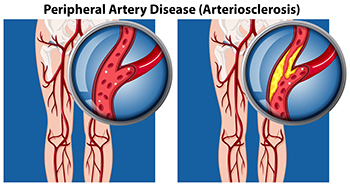Blog
Athlete’s Foot: Not Just for Athletes
Athlete’s Foot is a fungal infection that affects the skin on the feet. Despite its name, this fungal infection does not only occur in athletes. In fact, Athlete’s foot affects 1 out of 10 Americans. Athlete’s Foot is also known as dermatophytosis of the foot or tinea pedis. The fungi that are responsible for this condition feed on skin proteins called keratin, and love hot and steamy environments such as locker rooms, swimming pools, non-breathable footwear, and blisters and cuts on the feet which allow them access into your system. Getting a proper diagnosis is important in order for your podiatrist to rule out other conditions such as eczema and psoriasis, and to provide proper treatment.
Athlete’s foot is an inconvenient condition that can be easily reduced with the proper treatment. If you have any concerns about your feet and ankles, contact one of our podiatrists from James Kutchback, DPM, CWS-P. Our doctors will treat your foot and ankle needs.
Athlete’s Foot: The Sole Story
Athlete's foot, also known as tinea pedis, can be an extremely contagious foot infection. It is commonly contracted in public changing areas and bathrooms, dormitory style living quarters, around locker rooms and public swimming pools, or anywhere your feet often come into contact with other people.
Solutions to Combat Athlete’s Foot
- Hydrate your feet by using lotion
- Exfoliate
- Buff off nails
- Use of anti-fungal products
- Examine your feet and visit your doctor if any suspicious blisters or cuts develop
Athlete’s foot can cause many irritating symptoms such as dry and flaking skin, itching, and redness. Some more severe symptoms can include bleeding and cracked skin, intense itching and burning, and even pain when walking. In the worst cases, Athlete’s foot can cause blistering as well. Speak to your podiatrist for a better understanding of the different causes of Athlete’s foot, as well as help in determining which treatment options are best for you.
If you have any questions please feel free to contact our offices located in The Woodlands and Woodville, TX . We offer the newest diagnostic and treatment technologies for all your foot and ankle needs.
When to Consult With a Podiatrist
 The foot is composed of 26 bones along with a variety of joints, tendons, ligaments and muscles. A podiatrist is a doctor that specializes in conditions that impact these structures of the foot as well as the ankle. They can specialize in a variety of specific areas, such as surgery, wound care, sports injuries, and diabetic conditions. Podiatrists can treat a variety of conditions that include (but are not limited to) bunions, heel pain, flat feet, sprains, warts, nail conditions, and corns or calluses. Podiatrists should be consulted when there is severe foot pain, swelling, numbness, an open sore or a sign of infection that lasts multiple days. You should also consult with a podiatrist immediately if the foot or ankle cannot bear any weight.
The foot is composed of 26 bones along with a variety of joints, tendons, ligaments and muscles. A podiatrist is a doctor that specializes in conditions that impact these structures of the foot as well as the ankle. They can specialize in a variety of specific areas, such as surgery, wound care, sports injuries, and diabetic conditions. Podiatrists can treat a variety of conditions that include (but are not limited to) bunions, heel pain, flat feet, sprains, warts, nail conditions, and corns or calluses. Podiatrists should be consulted when there is severe foot pain, swelling, numbness, an open sore or a sign of infection that lasts multiple days. You should also consult with a podiatrist immediately if the foot or ankle cannot bear any weight.
If you are dealing with pain in your feet and ankles, you may want to seek help from a podiatrist. Feel free to contact one of our podiatrists from James Kutchback, DPM, CWS-P. Our doctors can provide the care you need to keep you pain-free and on your feet.
What Is a Podiatrist?
A podiatrist is a doctor of podiatric medicine who diagnoses and treats conditions of the foot, ankle, and related structures of the leg. Your podiatrist may specialize in a certain field such as sports medicine, wound care, pediatrics, and diabetic care. Podiatrists have the ability to become board certified through training, clinical experience, and then taking an exam.
What Do Podiatrists Do?
On a daily basis, a podiatrist may perform the following activities:
- Diagnose foot ailments such as ulcers, tumors, fractures, etc.
- Use innovative methods to treat conditions
- Use corrective orthotics, casts, and strappings to correct deformities
- Correct walking patterns and balance
- Provide individual consultations to patients
It is very important that you take care of your feet. It’s easy to take having healthy feet for granted, however foot problems tend to be among the most common health conditions. Podiatrists can help diagnose and treat a variety of feet related conditions, so it is crucial that you visit one if you need assistance.
If you have any questions, please feel free to contact our offices located in The Woodlands and Woodville, TX . We offer the newest diagnostic and treatment technologies for all your foot care needs.
Development of Potential Harmful Foot Conditions From Wearing Flip Flops
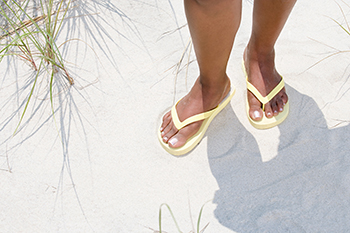 There are patients who have found their gait or walking style may have been altered if their lifestyle includes frequently wearing flip flops. The heel and ankles can negatively be affected, in addition to the skin on the feet when flip flops with no backs are worn often. Many people choose to wear this type of shoe for their ease and colorful designs, despite the potential damage they may cause. The toes can naturally scrunch in an effort to keep the shoe on the foot and performing this motion repeatedly can overstretch the plantar fascia, which is the band of tissue that connects the heel to the toes. If you enjoy wearing flip flops,please consult with a podiatrist who can recommend a more supportive sandal that can have less harmful side effects on the overall foot.
There are patients who have found their gait or walking style may have been altered if their lifestyle includes frequently wearing flip flops. The heel and ankles can negatively be affected, in addition to the skin on the feet when flip flops with no backs are worn often. Many people choose to wear this type of shoe for their ease and colorful designs, despite the potential damage they may cause. The toes can naturally scrunch in an effort to keep the shoe on the foot and performing this motion repeatedly can overstretch the plantar fascia, which is the band of tissue that connects the heel to the toes. If you enjoy wearing flip flops,please consult with a podiatrist who can recommend a more supportive sandal that can have less harmful side effects on the overall foot.
Flip-flops can cause a lot of problems for your feet. If you have any concerns about your feet or ankles, contact one of our podiatrists from James Kutchback, DPM, CWS-P. Our doctors will assist you with all of your foot and ankle needs.
Flip-Flops and Feet
Flip-flops have managed to become a summer essential for a lot of people. While the shoes may be stylish and easy to slip on and off, they can be dangerous to those who wear them too often. These shoes might protect you from fungal infections such as athlete’s foot, but they can also give you foot pain and sprained ankles if you trip while wearing them.
When Are They Okay to Wear?
Flip-flops should only be worn for very short periods of time. They can help protect your feet in places that are crawling with fungi, such as gym locker rooms. Athlete’s foot and plantar warts are two common fungi that flip-flops may help protect your feet against.
Why Are They Bad for My Feet?
These shoes do not offer any arch support, so they are not ideal for everyday use. They also do not provide shock absorption or heel cushioning which can be problematic for your feet. Additionally, you may suffer from glass cuts, puncture wounds, and stubbed toes since they offer little protection for your feet.
More Reasons Why They Are Bad for Your Feet
- They Slow You Down
- May Cause Blisters and Calluses
- Expose Your Feet to Bacteria
If you have any questions, please feel free to contact our offices located in The Woodlands and Woodville, TX . We offer the newest diagnostic and treatment technologies for all your foot care needs.
What Are the Reasons for Stress Fractures to Develop?
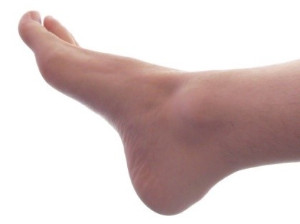 The most common reason for a stress fracture to develop is from overuse and participating in repetitive activities. Sporting events that require frequent running and jumping may cause stress fractures to gradually occur and this may cause pain and discomfort. Many patients may feel mild symptoms immediately following this type of injury and choose to ignore them. This can cause the stress fracture to worsen and the symptoms to intensify. People may also find if they increase the speed and duration of their training too quickly, a stress fracture may result from not gradually increasing speed and distance. Additionally, this type of ailment may occur from an abnormal foot structure or from wearing shoes that do not fit properly. If you incur this type of injury, it is suggested that you confer with a podiatrist when signs and symptoms first arise as there are several treatment options available.
The most common reason for a stress fracture to develop is from overuse and participating in repetitive activities. Sporting events that require frequent running and jumping may cause stress fractures to gradually occur and this may cause pain and discomfort. Many patients may feel mild symptoms immediately following this type of injury and choose to ignore them. This can cause the stress fracture to worsen and the symptoms to intensify. People may also find if they increase the speed and duration of their training too quickly, a stress fracture may result from not gradually increasing speed and distance. Additionally, this type of ailment may occur from an abnormal foot structure or from wearing shoes that do not fit properly. If you incur this type of injury, it is suggested that you confer with a podiatrist when signs and symptoms first arise as there are several treatment options available.
Activities where too much pressure is put on the feet can cause stress fractures. To learn more, contact one of our podiatrists from James Kutchback, DPM, CWS-P. Our doctors can provide the care you need to keep your pain free and on your feet.
Dealing with Stress Fractures of the Foot and Ankle
Stress fractures occur in the foot and ankle when muscles in these areas weaken from too much or too little use. The feet and ankles then lose support when walking or running from the impact of the ground. Since there is no protection, the bones receive the full impact of each step. Stress on the feet can cause cracks to form in the bones, thus creating stress fractures.
What Are Stress Fractures?
Stress fractures occur frequently in individuals whose daily activities cause great impact on the feet and ankles. Stress factors are most common among:
- Runners
- People affected with Osteoporosis
- Tennis or basketball players
- Gymnasts
- High impact workouts
Symptoms
Pain from the fractures occur in the area of the fractures and can be constant or intermittent. It will often cause sharp or dull pain with swelling and tenderness. Engaging in any kind of activity which involves high impact will aggravate pain.
If you have any questions please contact our offices located in The Woodlands and Woodville, TX . We offer the newest diagnostic and treatment technologies for all your foot and ankle needs.
How Peripheral Arterial Disease Affects the Feet
Peripheral arterial disease (PAD) occurs when the outer, or peripheral, arteries narrow due to a build-up of plaque. Peripheral arteries transport blood—which carries oxygen and nutrients—to the legs and arms, keeping the skin and underlying tissue alive and healthy. When PAD is present in the legs, it can reduce the normal amount of blood flow, oxygen, and nutrients to the feet. This may lead to dysfunction in the skin and tissue, causing it to break down and make it more susceptible to developing wounds. PAD can be an inherited disease, or may be caused by diabetes, hypertension, high cholesterol, or obesity. Symptoms of PAD in the feet may include burning, aching, coolness, redness, reoccurring infections, and sores in the toes and feet that do not heal. If you are experiencing any of these symptoms, contact a podiatrist for a full examination, testing, diagnosis and proper treatment.
Peripheral artery disease can pose a serious risk to your health. It can increase the risk of stroke and heart attack. If you have symptoms of peripheral artery disease, consult with one of our podiatrists from James Kutchback, DPM, CWS-P. Our doctors will assess your condition and provide you with quality foot and ankle treatment.
Peripheral artery disease (PAD) is when arteries are constricted due to plaque (fatty deposits) build-up. This results in less blood flow to the legs and other extremities. The main cause of PAD is atherosclerosis, in which plaque builds up in the arteries.
Symptoms
Symptoms of PAD include:
- Claudication (leg pain from walking)
- Numbness in legs
- Decrease in growth of leg hair and toenails
- Paleness of the skin
- Erectile dysfunction
- Sores and wounds on legs and feet that won’t heal
- Coldness in one leg
It is important to note that a majority of individuals never show any symptoms of PAD.
Diagnosis
While PAD occurs in the legs and arteries, Podiatrists can diagnose PAD. Podiatrists utilize a test called an ankle-brachial index (ABI). An ABI test compares blood pressure in your arm to you ankle to see if any abnormality occurs. Ultrasound and imaging devices may also be used.
Treatment
Fortunately, lifestyle changes such as maintaining a healthy diet, exercising, managing cholesterol and blood sugar levels, and quitting smoking, can all treat PAD. Medications that prevent clots from occurring can be prescribed. Finally, in some cases, surgery may be recommended.
If you have any questions, please feel free to contact our offices located in The Woodlands and Woodville, TX . We offer the newest diagnostic and treatment technologies for all your foot care needs.
Why Aging Feet Need Regular Care
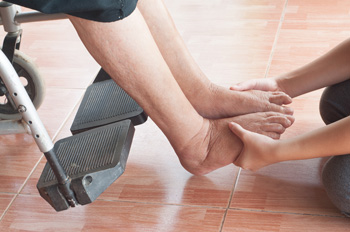 Foot care for the elderly is important as skin tends to thin out and lose elasticity, and nails can become dry and brittle—making the feet more susceptible to infections, blisters, toenail fungus, ingrown toenails, and more. It is important for an aging adult to practice regular foot care, or if they cannot do it themselves, have a caretaker do it. Toenails should be trimmed and filed regularly: straight across, and not too short in order to avoid ingrown toenails. Nail clippers should be sanitized and never shared. Feet should be cleaned, moisturized, and inspected daily for signs of infection which may include cracks, blisters, discolored nails, or bleeding sores. Footwear should be properly sized with good arch support to aid in mobility and prevent slips and falls. Shoes should never force the feet or toes into a position that is uncomfortable or restricts circulation. Additionally, older adults should make an appointment with a podiatrist for an examination and possibly even a gait analysis to detect and treat any developing or existing conditions.
Foot care for the elderly is important as skin tends to thin out and lose elasticity, and nails can become dry and brittle—making the feet more susceptible to infections, blisters, toenail fungus, ingrown toenails, and more. It is important for an aging adult to practice regular foot care, or if they cannot do it themselves, have a caretaker do it. Toenails should be trimmed and filed regularly: straight across, and not too short in order to avoid ingrown toenails. Nail clippers should be sanitized and never shared. Feet should be cleaned, moisturized, and inspected daily for signs of infection which may include cracks, blisters, discolored nails, or bleeding sores. Footwear should be properly sized with good arch support to aid in mobility and prevent slips and falls. Shoes should never force the feet or toes into a position that is uncomfortable or restricts circulation. Additionally, older adults should make an appointment with a podiatrist for an examination and possibly even a gait analysis to detect and treat any developing or existing conditions.
Everyday foot care is very important to prevent infection and other foot ailments. If you need your feet checked, contact one of our podiatrists from James Kutchback, DPM, CWS-P. Our doctors can provide the care you need to keep you pain-free and on your feet.
Everyday Foot Care
Often, people take care of their bodies, face and hair more so than they do for their feet. But the feet are a very important aspect of our bodies, and one that we should pay more attention to. Without our feet, we would not be able to perform most daily tasks.
It is best to check your feet regularly to make sure there are no new bruises or cuts that you may not have noticed before. For dry feet, moisturizer can easily be a remedy and can be applied as often as necessary to the affected areas. Wearing shoes that fit well can also help you maintain good foot health, as well as making it easier to walk and do daily activities without the stress or pain of ill-fitting shoes, high heels, or even flip flops. Wearing clean socks with closed shoes is important to ensure that sweat and bacteria do not accumulate within the shoe. Clean socks help to prevent Athlete’s foot, fungi problems, bad odors, and can absorb sweat.
If you have any questions, please feel free to contact our offices located in The Woodlands and Woodville, TX . We offer the newest diagnostic and treatment technologies for all your foot care needs.
Treatment For Diabetic Foot Ulcers
 Diabetic foot ulcers (DFUs) are slow-healing wounds that often form on the feet of people who have diabetes. These wounds may be difficult to detect until they have progressed to the point of causing noticeable symptoms or becoming infected. Your podiatrist may treat DFUs by removing pressure from the wound using a cast, boot, special footwear, or an off-loading device. Sometimes debriding the area, which involves removing damaged tissue from the wound site, is necessary. Keeping the foot clean, dry, and well moisturized is suggested in order to promote healing and prevent future wounds from developing. For more information about diabetic foot ulcers, please consult with a podiatrist.
Diabetic foot ulcers (DFUs) are slow-healing wounds that often form on the feet of people who have diabetes. These wounds may be difficult to detect until they have progressed to the point of causing noticeable symptoms or becoming infected. Your podiatrist may treat DFUs by removing pressure from the wound using a cast, boot, special footwear, or an off-loading device. Sometimes debriding the area, which involves removing damaged tissue from the wound site, is necessary. Keeping the foot clean, dry, and well moisturized is suggested in order to promote healing and prevent future wounds from developing. For more information about diabetic foot ulcers, please consult with a podiatrist.
Wound care is an important part in dealing with diabetes. If you have diabetes and a foot wound or would like more information about wound care for diabetics, consult with one of our podiatrists from James Kutchback, DPM, CWS-P. Our doctors will assess your condition and provide you with quality foot and ankle treatment.
What Is Wound Care?
Wound care is the practice of taking proper care of a wound. This can range from the smallest to the largest of wounds. While everyone can benefit from proper wound care, it is much more important for diabetics. Diabetics often suffer from poor blood circulation which causes wounds to heal much slower than they would in a non-diabetic.
What Is the Importance of Wound Care?
While it may not seem apparent with small ulcers on the foot, for diabetics, any size ulcer can become infected. Diabetics often also suffer from neuropathy, or nerve loss. This means they might not even feel when they have an ulcer on their foot. If the wound becomes severely infected, amputation may be necessary. Therefore, it is of the upmost importance to properly care for any and all foot wounds.
How to Care for Wounds
The best way to care for foot wounds is to prevent them. For diabetics, this means daily inspections of the feet for any signs of abnormalities or ulcers. It is also recommended to see a podiatrist several times a year for a foot inspection. If you do have an ulcer, run the wound under water to clear dirt from the wound; then apply antibiotic ointment to the wound and cover with a bandage. Bandages should be changed daily and keeping pressure off the wound is smart. It is advised to see a podiatrist, who can keep an eye on it.
If you have any questions please contact our offices located in The Woodlands and Woodville, TX . We offer the newest diagnostic and treatment technologies for all your foot and ankle needs.
What Could Be Causing My Foot Pain?
Over h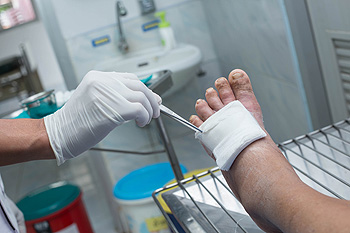 alf of diabetic patients suffer from nerve damage (diabetic neuropathy), which can, among other things, cause them to lose feeling and sensitivity in their feet. Those with diabetes who are also overweight, over 40, or who have high cholesterol, high blood pressure, or unmanageable blood sugar levels are more likely to develop neuropathy. If you have diabetic neuropathy along with poor circulation, you are at risk of developing a cut or other injury on your foot which may not heal properly, turning into a foot ulcer and becoming infected. In rare cases, an untreated diabetic foot ulcer could worsen and possibly lead to amputation. Neuropathy’s decreased sensitivity to pain and lack of feeling makes it incredibly important for the diabetic foot patient to check their feet daily for scratches, sores, blisters and corns, while being under the care of a podiatrist.
alf of diabetic patients suffer from nerve damage (diabetic neuropathy), which can, among other things, cause them to lose feeling and sensitivity in their feet. Those with diabetes who are also overweight, over 40, or who have high cholesterol, high blood pressure, or unmanageable blood sugar levels are more likely to develop neuropathy. If you have diabetic neuropathy along with poor circulation, you are at risk of developing a cut or other injury on your foot which may not heal properly, turning into a foot ulcer and becoming infected. In rare cases, an untreated diabetic foot ulcer could worsen and possibly lead to amputation. Neuropathy’s decreased sensitivity to pain and lack of feeling makes it incredibly important for the diabetic foot patient to check their feet daily for scratches, sores, blisters and corns, while being under the care of a podiatrist.
Diabetic foot care is important in preventing foot ailments such as ulcers. If you are suffering from diabetes or have any other concerns about your feet, contact one of our podiatrists from James Kutchback, DPM, CWS-P. Our doctors can provide the care you need to keep you pain-free and on your feet.
Diabetic Foot Care
Diabetes affects millions of people every year. The condition can damage blood vessels in many parts of the body, especially the feet. Because of this, taking care of your feet is essential if you have diabetes, and having a podiatrist help monitor your foot health is highly recommended.
The Importance of Caring for Your Feet
- Routinely inspect your feet for bruises or sores.
- Wear socks that fit your feet comfortably.
- Wear comfortable shoes that provide adequate support.
Patients with diabetes should have their doctor monitor their blood levels, as blood sugar levels play such a huge role in diabetic care. Monitoring these levels on a regular basis is highly advised.
It is always best to inform your healthcare professional of any concerns you may have regarding your feet, especially for diabetic patients. Early treatment and routine foot examinations are keys to maintaining proper health, especially because severe complications can arise if proper treatment is not applied.
If you have any questions, please feel free to contact our offices located in The Woodlands and Woodville, TX . We offer the newest diagnostic and treatment technologies for all your foot care needs.






